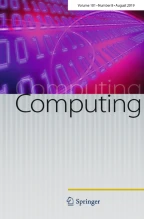Abstract
This paper gives an algorithm for determining the setU 0(Θ) of all maximal independent subsets of a finite poset Θ=(A, O), based on a (complex) Θ-induced arrangement ofU 0(Θ) as a rooted tree. By this procedure, all essential data manipulations can be restricted to certain bipartite graphs, thereby leading to a computation complexity not exceedingO(|A|·|\(\underset{\raise0.3em\hbox{$\smash{\scriptscriptstyle-}$}}{O} \)) per maximal independent subset obtained (where\(\underset{\raise0.3em\hbox{$\smash{\scriptscriptstyle-}$}}{O} \) denotes the immediate ordering relations). In fact, an intensive study of examples (with |A| ranging from 10–200) even showed almost total independence of external parameters such as |A|, |O| or |\(\underset{\raise0.3em\hbox{$\smash{\scriptscriptstyle-}$}}{O} \)| and at the same time led to considerably low computation times. Thus, in particular, the application of standard graph-theoretical methods to the associated comparability graph of Θ would no longer seem a reasonable approach to the considered problem.
Zusammenfassung
Es wird ein Algorithmus entwickelt, welcher das SystemU 0(Θ) aller unabhängigen Mengen einer endlichen Ordnung Θ=(A, O) generiert, und zwar aufbauend auf einer (komplizierten) Darstellung vonU 0(Θ) als Wurzelbaum. Hierbei können alle wesentlichen Datenmanipulationen innerhalb zugehöriger bipartiter Graphen durchgeführt werden, woraus eine Komplexität von höchstensO(|A|·|\(\underset{\raise0.3em\hbox{$\smash{\scriptscriptstyle-}$}}{O} \)) pro gefundener maximal unabhängiger Menge resultiert (\(\underset{\raise0.3em\hbox{$\smash{\scriptscriptstyle-}$}}{O} \) bezeichnet die unmittelbaren Ordnungs-relationen). Tatsächlich zeigte eine intensive Untersuchung von Beispielen mit Trägermengen der Kardinalität 10 bis 200 nahezu überhaupt keine Abhängigkeit der durchschnittlichen Rechenzeit von externen Parametern (wie |A|, |O| und |\(\underset{\raise0.3em\hbox{$\smash{\scriptscriptstyle-}$}}{O} \)|). Zudem ergaben sich erstaunlich niedrige Rechenzeiten. Insgesamt erweist sich somit der Algorithmus als empfehlenswerte Alternative gegenüber der Anwendung der bekannten graphentheoretischen Verfahren auf den zu Θ gehörenden Vergleichbarkeitsgraphen.
Similar content being viewed by others
Explore related subjects
Discover the latest articles, news and stories from top researchers in related subjects.References
Aho, A. V., Hopcraft, J. E., Ullmann, J. D.: The design and analysis of computer algorithms. Reading, Mass.: Addison-Wesley 1974.
Berge, C.: Principles of combinatorics. London: Academic Press 1971.
Bollobas, B.: Graph theory. (Graduate texts in Mathematics, Vol. 63.) New York: Springer 1979.
Bollobas, B., Erdös, P.: Cliques in random graphs. Math. Proc. Camb. Phil. Soc.80, 419–427 (1976).
Bron, C., Kerbosch, J.: Algorithm 457, Finding all cliques of an undirected graph. Comm. ACM16, 575–577 (1973).
Buer, H., Möhring, R. H.: A fast algorithm for the decomposition of graphs and acyclic networks (extended abstract). Forthcoming in Oper. Res. Verfahren37, 259–263 (1980).
Dilworth, R. P.: Some combinatorial problems on partially ordered sets in “Combinatorial Analysis”. Proc. Symp. Appl. Math., Vol. 10, pp. 85–90. Providence, R. I.: American Mathematical Society 1960.
Even, S., Pnueli, A., Lempel, A.: Permutation graphs and transitive graphs. J. of the Ass. f. Comp. Mach.19, 400–410 (1972).
Gerhards, L., Lindenberg, W.: Clique detection for nondirected graphs: Two new algorithms. Computing21, 295–322 (1979).
Gilmore, P. C., Hoffmann, A. J.: A characterization of comparability graphs and of interval graphs. Can. J. Math.16, 539–548 (1964).
Golumbic, M. C.: Comparability graphs and a new matroid. J. of comb. Theory (B)22, 68–90 (1977).
Golumbic, M. C.: The complexity of comparability graph recognition and coloring. Computing18, 199–208 (1977).
Gorenstein, S.: An algorithm for project (Job) sequencing with resource constraints. Operations Research20, 4 (1972).
Kaerkes, R.: Netzplan-Theorie. Operations-Research-Verfahren27, 1–65 (1976).
Lawler, E. L.: Combinatorial optimization: Networks and matroids. New York: Holt, Rinehart and Winston 1976.
Mirsky, L.: A dual of Dilworth's decomposition theorem. Amer. Math. Monthly78, 876–877 (1971).
Radermacher, F. J.: Kapazitätsoptimierung in Netzplänen. (Mathematical Systems in Economics, Band 40.) Meisenheim am Glan: Verlag Anton Hain 1978.
Tsukiyama, S., Ide, H., Ariyoshi, H., Shirakawa, I.: A new algorithm for generating all the maximal independent sets. Siam J. Comput.6, 505–517 (1977).
Author information
Authors and Affiliations
Additional information
This paper was supported by the Minister für Wissenschaft und Forschung des Landes NRW, Federal Republic of Germany.
Rights and permissions
About this article
Cite this article
Bartusch, M. An algorithm for generating all maximal independent subsets of posets. Computing 26, 343–354 (1981). https://doi.org/10.1007/BF02237953
Received:
Revised:
Issue Date:
DOI: https://doi.org/10.1007/BF02237953
